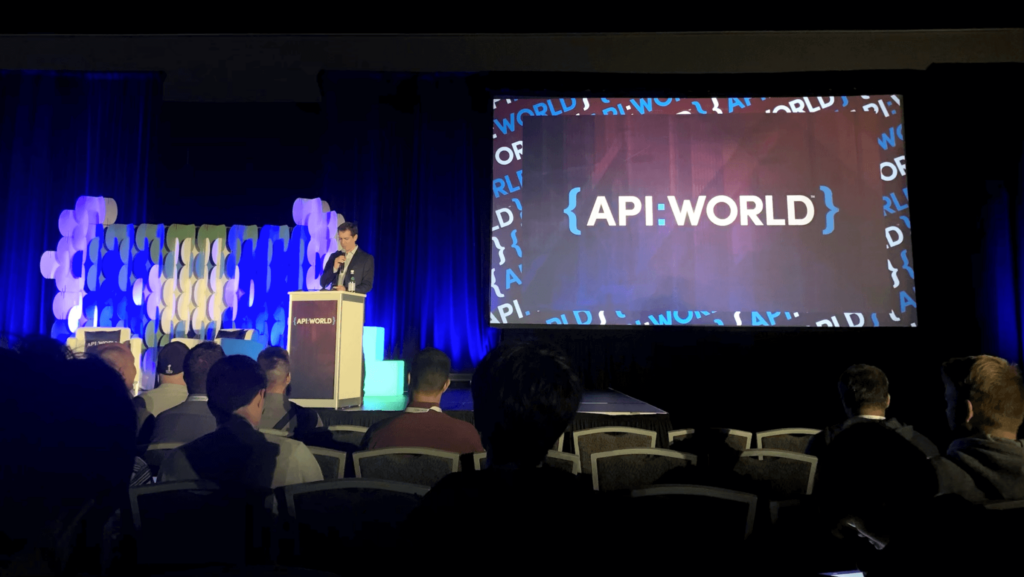Top 5 Industry Trends from API World 2019

Last week, we traveled to Silicon Valley for the 8th annual API World conference to network with and learn from industry leaders representing companies around the country. In addition to our Developer Experience Director, James Messinger, the speaker lineup included technical leadership teams from IBM, JPMorganChase, Intuit, PayPal, and eBay—just to name a few.
Throughout the conference, we noticed that conversations and presentations focused on several common themes in regard to the current and future state of API development. So, we thought it would be fun to share what we learned. Below, we’ve outlined 5 trends we noticed at API World 2019:
1. Companies with APIs are developing in-house auto-generators rather than outsourcing to third-party providers
Auto-generators can be both a huge expense and time saver for API companies, not to mention they can significantly improve the developer experience, so it’s no wonder why a market exists for API tools like Swagger CodeGen, and others. However, third-party auto-generators can be challenging since APIs are not one-size-fits-all.
At API World 2019, it became clear that more and more companies are opting to develop in-house auto-generators to help build their client libraries, code samples, reference docs, and more. IBM, in particular, spoke to how their development of an auto-generator and linter within API Connect has enabled them to develop higher-quality code for their users.
2. There remains a lingering debate on microservices vs. monoliths
This is not a new issue, as developers and architects have been weighing the pros and cons of microservices versus monoliths for nearly half a decade. However, it became apparent last week that we may finally have some answers to the ongoing debate.
Monolith applications have historically been regarded as the tried-and-true style of API architecture. But, as with most things in this space, we’re enamored with anything that promises to do more, faster. Since microservices allow you to segment your application with various offerings, they tend to provide better speed, better scalability and more flexibility. However, the complexity of a distributed system can weigh heavily on a development team, particularly with those just starting to establish their proof of concept.
At the end of the day, it’s important to weigh the associated business risks with each style of architecture to determine the right path for your API.
3. Document your API for humans—including entry-level developers—with the goal of self-service
APIs are beginning to dominate the marketplace, as businesses—small and large—begin to realize the potential benefits they offer. With this surge, companies have realized the importance of catering their APIs to a wider audience. No longer can we rely on developers to be the primary consumers of APIs, and we therefore need to develop strong documentation that is understood by the masses.

4. Successfully marketed APIs utilize a team of researchers, technical writers, content strategists and UI/UX developers
Because we’re experiencing a shift in the way APIs are documented and marketed, it’s important to construct a well-balanced team that can achieve the goal of writing for humans. Deborah Foley of JPMorganchase’s Developer Ecosystem attributes a large part of their developer experience success to building teams across disciplines; including researchers, technical writers, content strategists, and UI/UX developers. By pairing technical experts with writers and marketing professionals to work closely together from the beginning, there’s the ability to painlessly plan and execute a thoughtful message that’s easily understood by nearly every consumer of your API.
5. Optimize your developer experience and foster customer loyalty by prioritizing “Time to First Hello World” over trial signups
As an API company, there will always be a huge internal push to generate trial signups—and understandably so. A trial signup is the one thing most teams, from marketing to dev, agree to mean “success.” While trial signups can be great indicators of your success in the industry, they may not be the most important aspect of developing your go-to-market strategy. Derric Gilling of Moesif outlined how prioritizing “Time to First Hello World”—or the amount of time it takes a user to fully integrate and go live with your API—could be the key to building an API that developers love.
By prioritizing TTFHW, you open yourself up to a world of new metrics that can be used to better measure your success as an API as well as to improve your product. For example, if users are taking longer than expected in the sandbox phase, it could mean that there are opportunities to better clarify your documentation. This strategy recognizes that there is no true customer value until a user is successfully integrated with your API, and focuses more on the quality of developer experience than simply getting people through the door.
—-
With more than 3,500 attendees, every day of API World 2019 was rich with knowledge, and we were able to leave with new insights on how to continue creating and delivering to our users the best shipping API available. We even had the chance to attend a couple of workshops within the AI Dev World conference, and the ShipEngine team was amazed by the future potential of AI and Machine Learning in e-commerce.
One quick takeaway: Get ready for mind reading technology, from companies like Facebook and Elon Musk’s Nuralink, to influence the way your brand interacts with consumers.
To stay in-the-loop about other conferences and events we’re attending, feel free to follow along on Instagram or browse through our event recaps on the blog.



